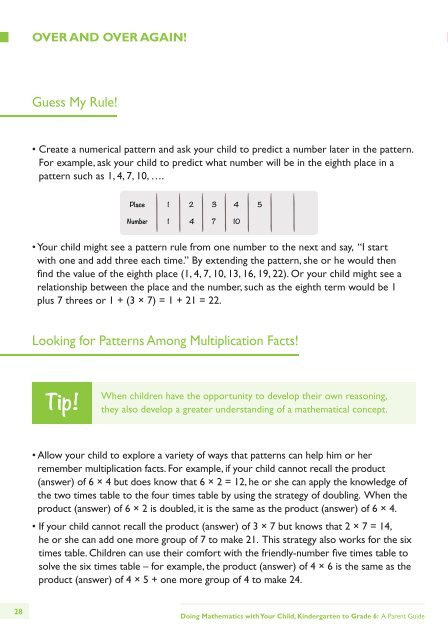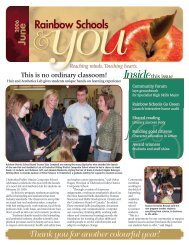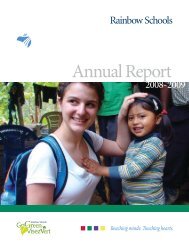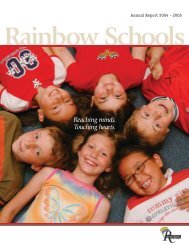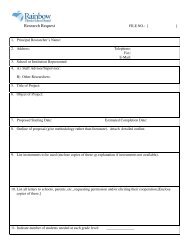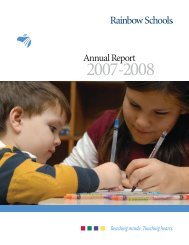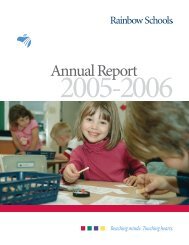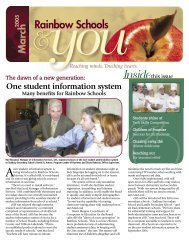Doing Mathematics with Your Child, Kindergarten to ... - EduGains
Doing Mathematics with Your Child, Kindergarten to ... - EduGains
Doing Mathematics with Your Child, Kindergarten to ... - EduGains
Create successful ePaper yourself
Turn your PDF publications into a flip-book with our unique Google optimized e-Paper software.
Over and over again!<br />
Guess My Rule!<br />
• Create a numerical pattern and ask your child <strong>to</strong> predict a number later in the pattern.<br />
For example, ask your child <strong>to</strong> predict what number will be in the eighth place in a<br />
pattern such as 1, 4, 7, 10, ….<br />
Place<br />
Number<br />
• <strong>Your</strong> child might see a pattern rule from one number <strong>to</strong> the next and say, “I start<br />
<strong>with</strong> one and add three each time.” By extending the pattern, she or he would then<br />
find the value of the eighth place (1, 4, 7, 10, 13, 16, 19, 22). Or your child might see a<br />
relationship between the place and the number, such as the eighth term would be 1<br />
plus 7 threes or 1 + (3 × 7) = 1 + 21 = 22.<br />
Looking for Patterns Among Multiplication Facts!<br />
1<br />
1<br />
2<br />
4<br />
3<br />
7<br />
4<br />
10<br />
5<br />
WHat are the chances?<br />
You will find activities that support Data Management and Probability in<br />
the pink pages. This is the strand in the Ontario mathematics curriculum that<br />
introduces your child <strong>to</strong> how <strong>to</strong> collect, organize and interpret information.<br />
Every day children are presented <strong>with</strong> a vast amount of information, much of it<br />
involving numbers.<br />
Legend<br />
Numbers are everywhere!<br />
How high? How low? How much? How little?<br />
What’s your angle on that?<br />
Over and over again!<br />
What are the chances?<br />
<strong>Kindergarten</strong> <strong>to</strong> Grade 3<br />
Tip!<br />
When children have the opportunity <strong>to</strong> develop their own reasoning,<br />
they also develop a greater understanding of a mathematical concept.<br />
• Allow your child <strong>to</strong> explore a variety of ways that patterns can help him or her<br />
remember multiplication facts. For example, if your child cannot recall the product<br />
(answer) of 6 × 4 but does know that 6 × 2 = 12, he or she can apply the knowledge of<br />
the two times table <strong>to</strong> the four times table by using the strategy of doubling. When the<br />
product (answer) of 6 × 2 is doubled, it is the same as the product (answer) of 6 × 4.<br />
7 = 2 + 5<br />
• If your child cannot recall the product (answer) of 3 × 7 but knows that 2 × 7 = 14,<br />
he or she can add one more group of 7 <strong>to</strong> make 21. This strategy also works for the six<br />
times table. <strong>Child</strong>ren can use their comfort <strong>with</strong> the friendly-number five times table <strong>to</strong><br />
solve the six times table – for example, the product (answer) of 4 × 6 is the same as the<br />
product (answer) of 4 × 5 + one more group of 4 <strong>to</strong> make 24.<br />
7 = 2 + 5<br />
28<br />
<strong>Doing</strong> <strong>Mathematics</strong> <strong>with</strong> <strong>Your</strong> <strong>Child</strong>, <strong>Kindergarten</strong> <strong>to</strong> Grade 6: A Parent Guide<br />
<strong>Doing</strong> <strong>Mathematics</strong> <strong>with</strong> <strong>Your</strong> <strong>Child</strong>, <strong>Kindergarten</strong> <strong>to</strong> Grade 6: A Parent Guide<br />
29


